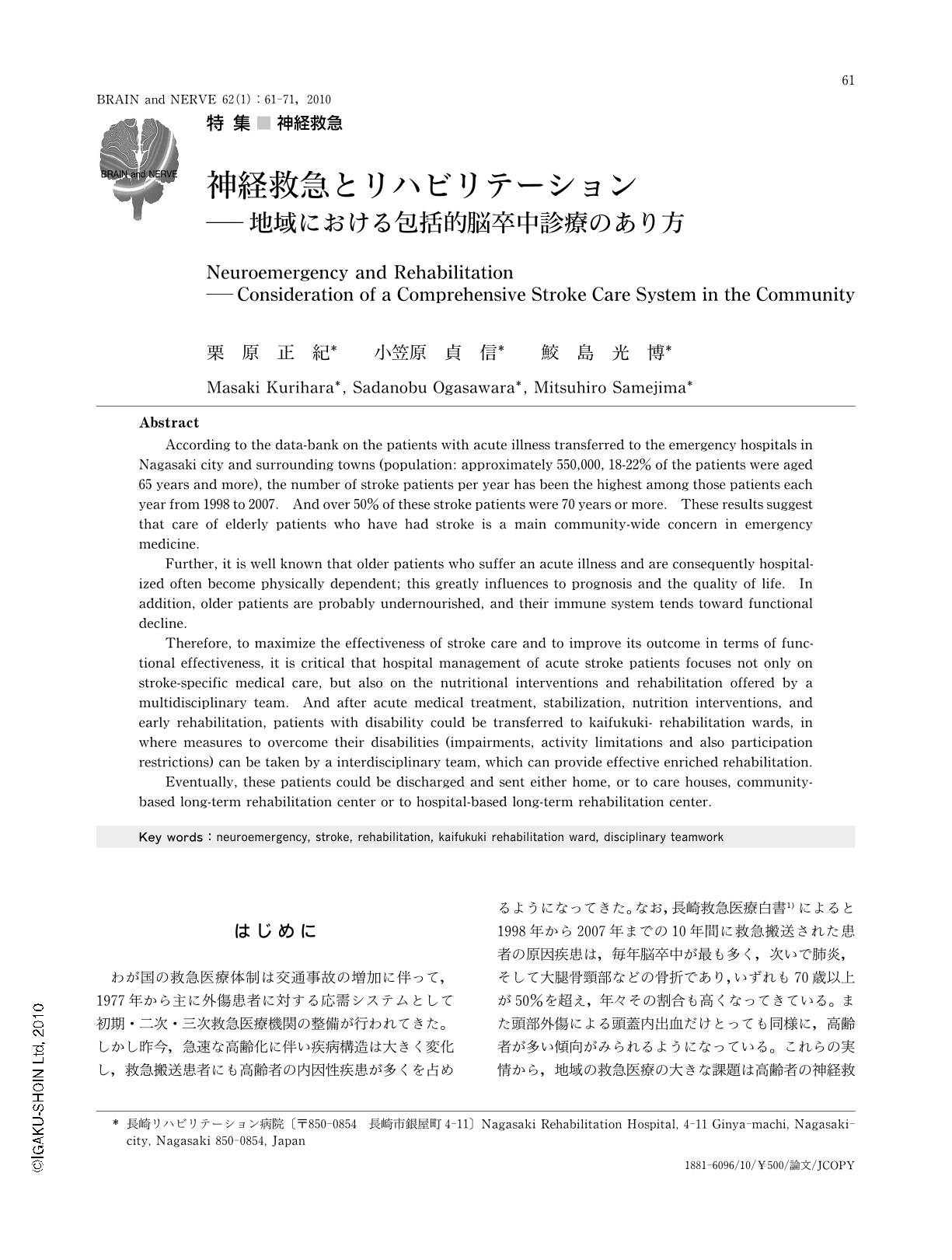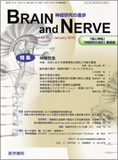Japanese
English
- 有料閲覧
- Abstract 文献概要
- 1ページ目 Look Inside
- 参考文献 Reference
はじめに
わが国の救急医療体制は交通事故の増加に伴って,1977年から主に外傷患者に対する応需システムとして初期・二次・三次救急医療機関の整備が行われてきた。しかし昨今,急速な高齢化に伴い疾病構造は大きく変化し,救急搬送患者にも高齢者の内因性疾患が多くを占めるようになってきた。なお,長崎救急医療白書1)によると1998年から2007年までの10年間に救急搬送された患者の原因疾患は,毎年脳卒中が最も多く,次いで肺炎,そして大腿骨頸部などの骨折であり,いずれも70歳以上が50%を超え,年々その割合も高くなってきている。また頭部外傷による頭蓋内出血だけとっても同様に,高齢者が多い傾向がみられるようになっている。これらの実情から,地域の救急医療の大きな課題は高齢者の神経救急疾患であることがわかる。
一方,リハビリテーション(以下,リハビリ)医療は従来,全身状態が完全に安定してから開始され,主たる対象はリウマチや若い人の脊髄損傷・骨折などの整形疾患であり,一般的に慢性期の医療として認識されていた。ところが2000年に大きな転換期が訪れた。そのきっかけは介護保険法の成立と回復期リハビリ病棟の誕生である。介護保険はリハビリ前置主義が唱えられ,その主要な場として回復期リハビリ病棟の位置づけがある。さらに,急性期医療における平均在院日数の短縮化も加わり,急性期(救急)医療,亜急性期医療,そして慢性期医療という医療機能の分担化が促進されるに従い,回復期リハビリ病棟が急性期(救急)後の亜急性期医療の場として期待されるようにもなってきた。このように近年,リハビリ医療は救急医療と切っても切れない密接な関係として捉えられ,その重要性が幅広く認識されているところである。
超高齢社会を目前に,“高度に進歩した専門的治療を如何にして効果的・効率的に地域生活に繋げていくか”地域医療のあり方が問われている。その抜本的対策は“高齢者の特徴2)を踏まえた救急医療とリハビリ医療の包括的展開”にあると考える。
そこで本稿では神経救急疾患の中で最も多い脳卒中を取り上げ,地域における包括的脳卒中診療のあり方とリハビリについて私見を交えながら整理する。
Abstract
According to the data-bank on the patients with acute illness transferred to the emergency hospitals in Nagasaki city and surrounding towns (population: approximately 550,000, 18-22% of the patients were aged 65 years and more), the number of stroke patients per year has been the highest among those patients each year from 1998 to 2007. And over 50% of these stroke patients were 70 years or more. These results suggest that care of elderly patients who have had stroke is a main community-wide concern in emergency medicine.
Further, it is well known that older patients who suffer an acute illness and are consequently hospitalized often become physically dependent; this greatly influences to prognosis and the quality of life. In addition, older patients are probably undernourished, and their immune system tends toward functional decline.
Therefore, to maximize the effectiveness of stroke care and to improve its outcome in terms of functional effectiveness, it is critical that hospital management of acute stroke patients focuses not only on stroke-specific medical care, but also on the nutritional interventions and rehabilitation offered by a multidisciplinary team. And after acute medical treatment, stabilization, nutrition interventions, and early rehabilitation, patients with disability could be transferred to kaifukuki- rehabilitation wards, in where measures to overcome their disabilities (impairments, activity limitations and also participation restrictions) can be taken by a interdisciplinary team, which can provide effective enriched rehabilitation.
Eventually,these patients could be discharged and sent either home,or to care houses,community-based long-term rehabilitation center or to hospital-based long-term rehabilitation center.

Copyright © 2010, Igaku-Shoin Ltd. All rights reserved.


